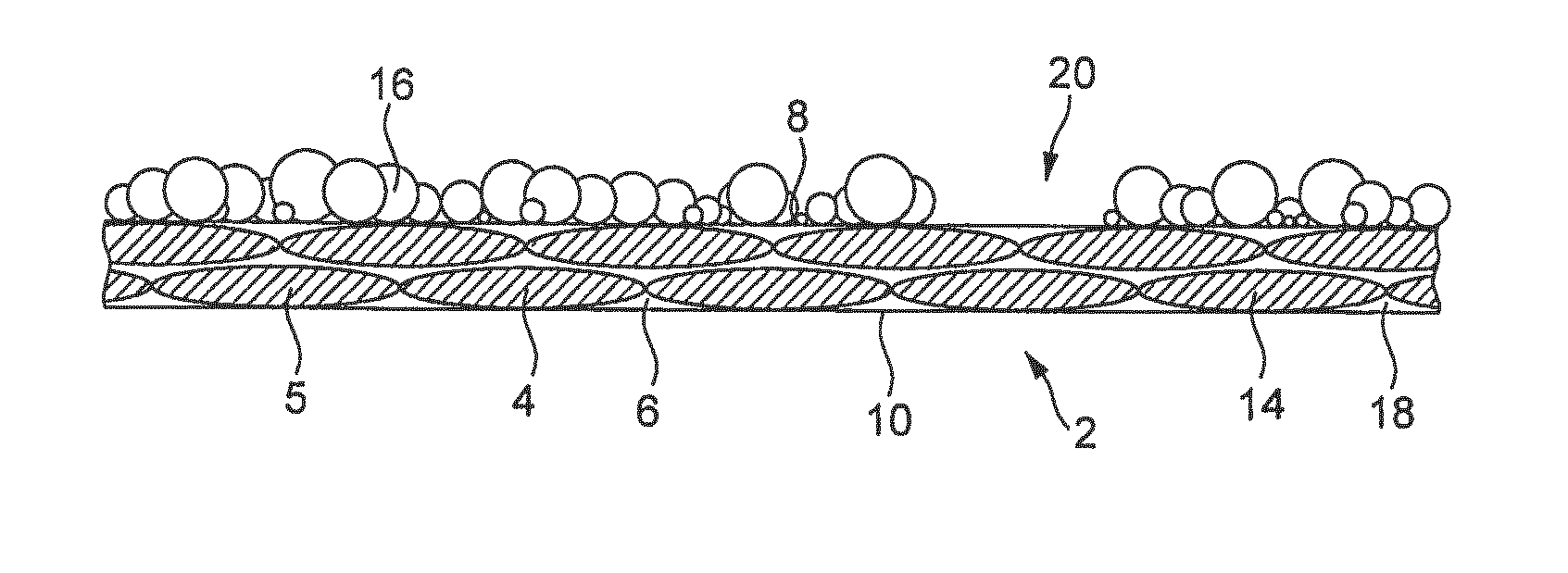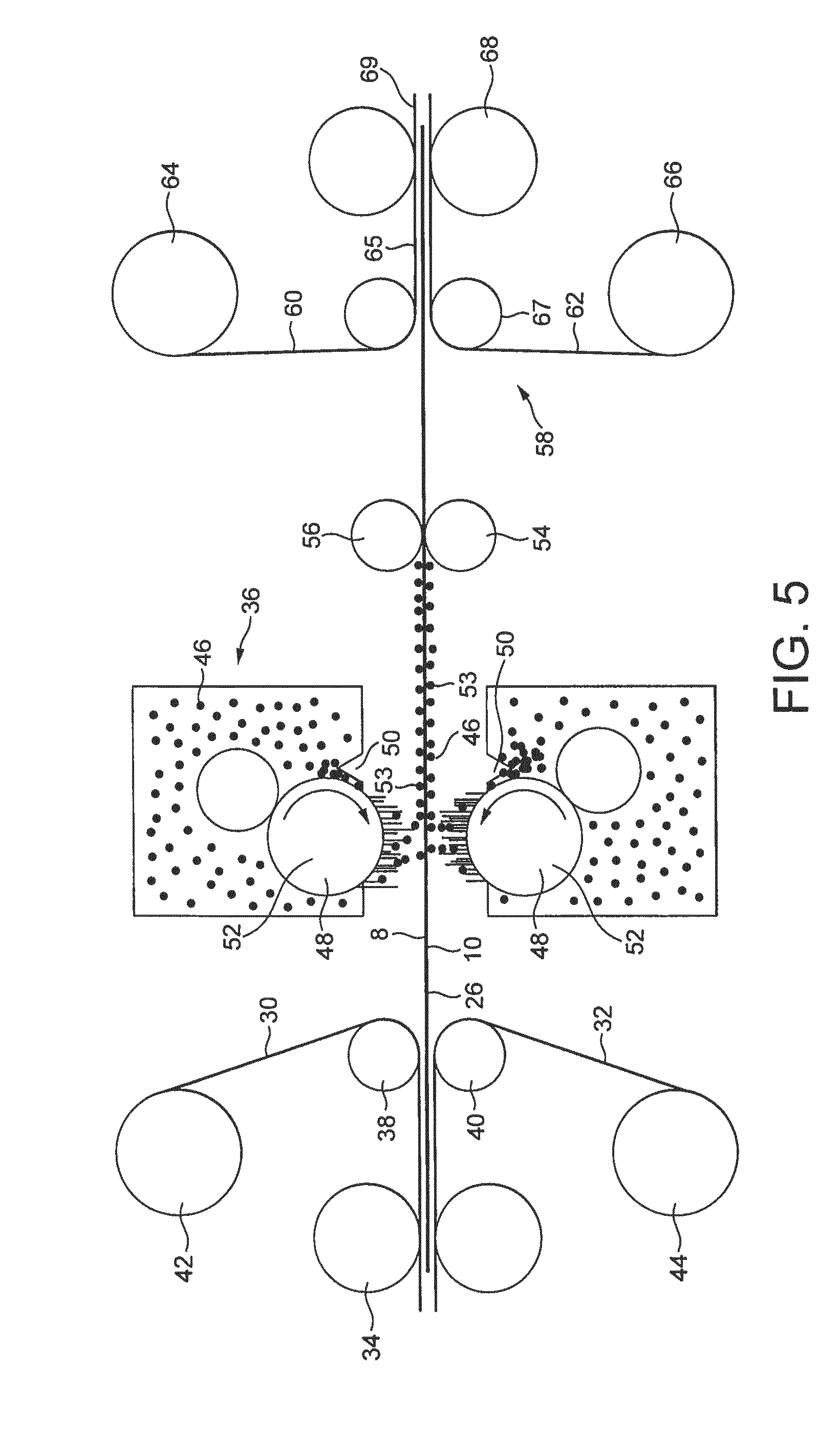Prepreg for manufacturing composite materials
- Summary
- Abstract
- Description
- Claims
- Application Information
AI Technical Summary
Benefits of technology
Problems solved by technology
Method used
Image
Examples
example 1
[0159]A fully impregnated carbon fibre prepreg having an epoxy matrix resin was manufactured. The carbon fibres were unidirectional (UD) fibres having a fibre weight of 600 grams per square metre. The prepreg had a resin content of 35% by weight, based on the weight of the prepreg. The epoxy resin was a commercially available prepreg resin, in particular a diglycidyl ether of bisphenol A (DGEBA) epoxy prepreg resin incorporating a dicyandiamide / urea curing system. The resin had low tack (Tack rating QC-2 at 20° C.). The resin is available in commerce from Gurit (UK) Limited, Newport, UK, under the trade name Gurit SPX17551. The epoxy matrix resin, designated as resin A, had the viscosity / temperature profile as shown in FIG. 9.
[0160]The tack rating is as follows: ZT—Zero Tack; QC-0 Does not stick at all. Surface dry to the touch; LT Low Tack—gloved finger easily removed after touching surface; QC-1 Sticks only with firm pressure. Parts very easily. Surface quite dry to the touch; QC-...
example 2
[0175]Example 2 produced a powder coated prepreg in a manner similar to Example 1. However, the prepreg matrix resin was different, and the amount of powder applied to the prepreg surfaces was modified.
[0176]The epoxy matrix resin of the prepreg was a commercially available prepreg resin, in particular a diglycidyl ether of bisphenol A (DGEBA) epoxy prepreg resin incorporating a dicyandiamide / urea curing system available in commerce from Gurit (UK) Limited, Newport, UK, under the trade name Gurit WE91-2. The resin had mid tack (Tack rating QC-3 at 22° C.). The epoxy matrix resin, designated as resin B, had the viscosity / temperature profile as shown in FIG. 9.
[0177]The powder coating was 7 grams per square metre on the each surface of the prepreg. The resulting prepreg was substantially coated and free from resin tack.
[0178]The powder coated prepreg was then tested to determine its drape limit, tack limit, void limit and temperature range for processing.
[0179]The results are shown in...
examples 3 to 8
[0202]Examples 3 to 8 each produced a powder coated prepreg in a manner similar to Example 2. However, the prepreg matrix resin was different, the powder particle size was different, the amount of powder applied to the prepreg surfaces was modified, and the powder application process and conditions were modified.
[0203]The prepreg was the same as that of Example 2, incorporating the epoxy matrix resin designated as resin B.
[0204]The production of a powder coating was as follows. A DGEBA epoxy resin having an epoxy equivalent weight of 840-900 gmol−1 (measured according to EN ISO 3001) and a softening point of 110-112° C. (measured according to EN ISO 4625) was provided. The resin is available in commerce from Nan Ya Plastics Corporation of Taipei, Taiwan under the trade name NPES 904H. The resin was ground to give a powder and then calibrated into a series of set particle size ranges using a series of woven wire mesh sieves conforming to IOS 3310.
[0205]Example 3 had a particle size o...
PUM
| Property | Measurement | Unit |
|---|---|---|
| Temperature | aaaaa | aaaaa |
| Temperature | aaaaa | aaaaa |
| Temperature | aaaaa | aaaaa |
Abstract
Description
Claims
Application Information
 Login to View More
Login to View More - R&D
- Intellectual Property
- Life Sciences
- Materials
- Tech Scout
- Unparalleled Data Quality
- Higher Quality Content
- 60% Fewer Hallucinations
Browse by: Latest US Patents, China's latest patents, Technical Efficacy Thesaurus, Application Domain, Technology Topic, Popular Technical Reports.
© 2025 PatSnap. All rights reserved.Legal|Privacy policy|Modern Slavery Act Transparency Statement|Sitemap|About US| Contact US: help@patsnap.com



